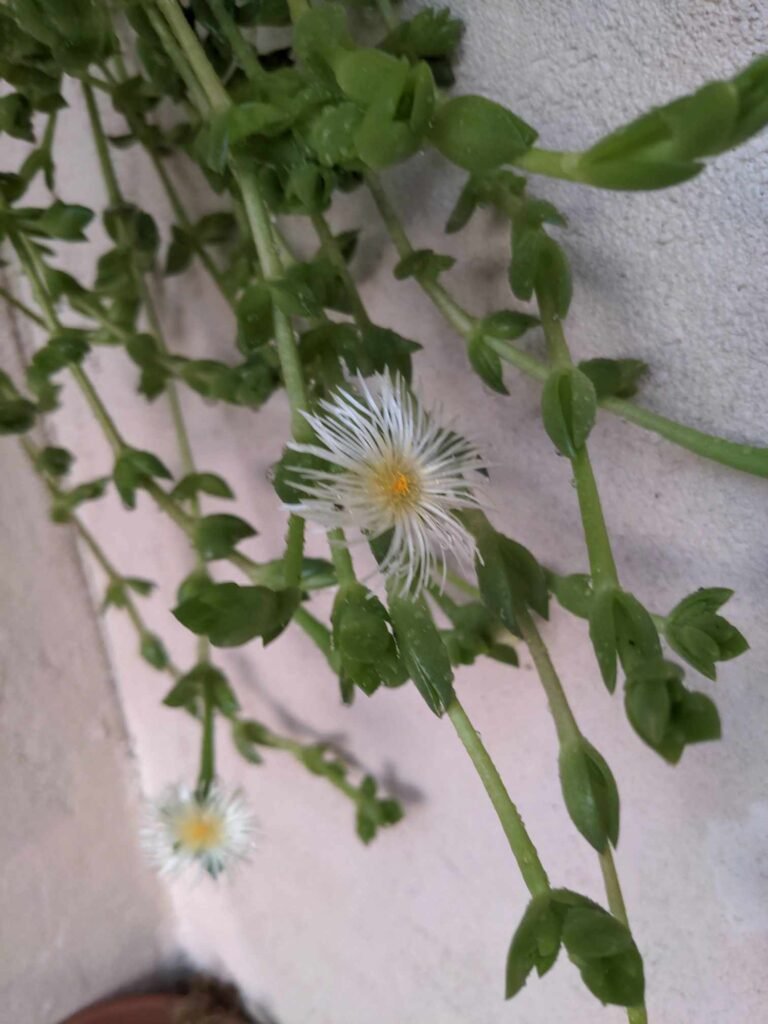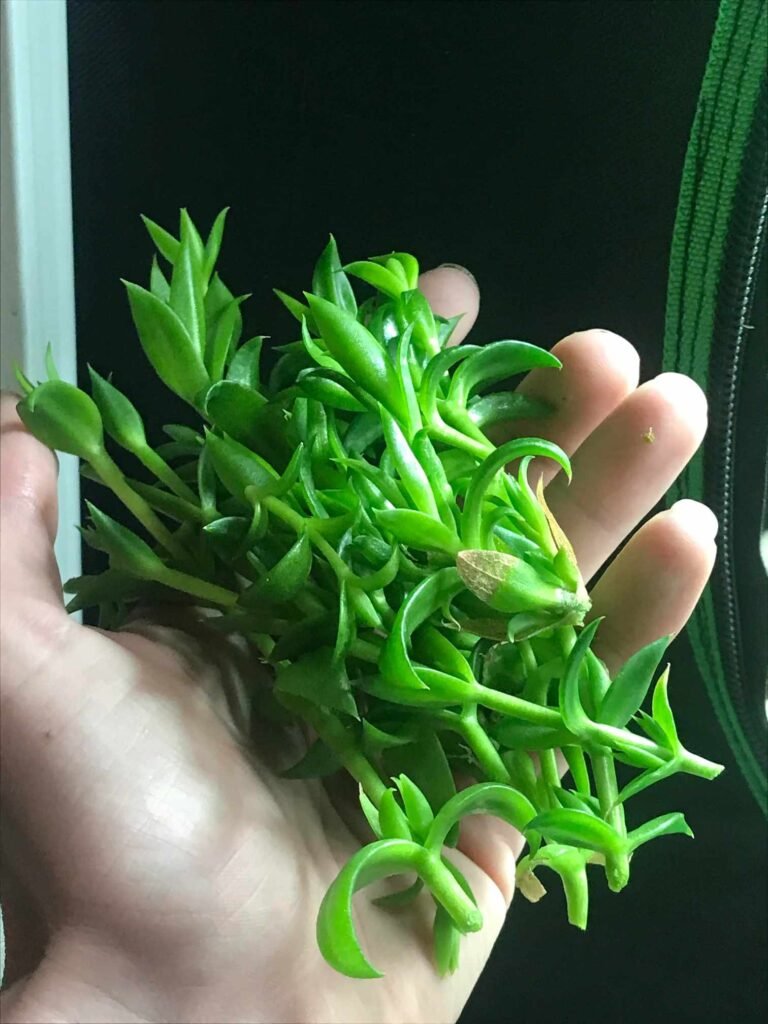What is Kanna?
Welcome to a world where gardening is not just a hobby but a journey of discovery and connection. I am a woman who has found a deep love and respect for the earth and its gifts. Among the many plants I’ve nurtured, Kanna, or Sceletium tortuosum, has been a unique and enlightening presence in my garden. In this guide, I’ll take you through the intricacies of growing this fascinating herb, interweaving my personal experiences and insights to help you cultivate it successfully.


Understanding Kanna
Kanna, known scientifically as Sceletium tortuosum, is not just another plant in my garden; it’s a vibrant chapter in the story of traditional African medicine and a testament to the healing power of nature. This herb, celebrated for its mood-enhancing properties, has become a cherished part of my daily life. My journey with Kanna began out of curiosity and has evolved into a deep appreciation for its cultural and medicinal significance. As I tend to its needs, I feel a connection to a centuries-old tradition of healing and wellness. In this section, I’ll share more about its history, uses, and the personal experiences that have made growing Kanna a rewarding part of my gardening adventure.

Seed Selection and Preparation
As a gardening enthusiast, I understand the excitement and importance of choosing the right Kanna seeds for your garden. When picking these little gems, think of them as potential new plants waiting to burst into life. You want to look for seeds that practically glow with health – a vibrant color and a full, robust shape are your tell-tale signs of vitality. These seeds are eager to grow, just like you’re eager to plant them!
Once you’ve selected your perfect seeds, the next step is to store them properly. This isn’t complicated at all – just remember ‘cool and dry.’ A cupboard away from direct sunlight or a dry shelf in your basement works perfectly. This simple storage trick keeps your seeds in a dormant, yet ready state, eager to sprout when you’re ready to plant.
Key Points for Seed Selection and Preparation:
- Vibrant Color & Full Shape: Look for seeds that are bright and plump.
- Proper Storage: Keep them in a cool, dry place away from direct sunlight.
- Patient Preparation: Store them until the moment feels right for planting.
| Feature | Description | Importance |
|---|---|---|
| Source | Reputable suppliers | Ensures genetic purity |
| Appearance | Plump, undamaged | Indicates seed health |
| Storage | Cool, dry conditions | Preserves viability |

Germination Techniques
Now, let’s talk about germinating these precious Kanna seeds. If you’ve gone through the initial germination steps, great job! Here’s a little extra nudge to help your seeds along. Consistency is your best friend in the germination phase. Kanna seeds are like sun-loving people; they thrive in warmth.
If your local climate tends to be on the cooler side, don’t worry! A simple solution is to use a heat mat. It’s like giving your seeds their own cozy blanket, ensuring they stay warm and comfy. This steady warmth can make a world of difference, providing the perfect snug environment for your seeds to start sprouting.
Extra Germination Tips:
- Consistent Warmth: Maintain a warm temperature, especially if you’re in a cooler climate.
- Use of Heat Mat: Consider investing in a heat mat for an extra boost in warmth.
- Patience is Key: Remember, good things take time – your seeds will sprout with consistent care.
Remember, gardening is a journey of love and patience. These tips will help you embark on this exciting adventure with Kanna seeds!

Priming Effect
Moving beyond germination, the ‘priming effect’ of Kanna in terms of its impact on the user is an intriguing phenomenon. Some individuals may not experience Kanna’s effects immediately upon first use. It’s often observed that consuming Kanna consistently for a few days can ‘prime’ the body, leading to a more noticeable impact. This aspect of priming is crucial for understanding and experiencing the full potential of Kanna.
Why Priming is Necessary
The reason behind this priming phase lies in how Kanna interacts with the body’s chemistry. Regular intake over a short period may help the body adjust and respond more effectively to the herb’s active compounds. This period of adjustment is vital for Kanna to exert its mood-enhancing and stress-relieving effects.
Quality Matters
If you’ve followed the priming process and still don’t observe any effects, it could be an indicator of the Kanna’s quality. Not all Kanna is created equal; factors such as how it’s grown, harvested, and processed play significant roles in its potency. Poor quality Kanna may not provide the desired effects, regardless of the priming process.
| Aspect | Indicators of Quality | Importance |
|---|---|---|
| Source | Reputable, specialized vendors | Ensures higher quality and purity |
| Appearance | Freshness and color of the herb | Fresh, vibrant Kanna is more likely to be potent |
| Processing | Proper drying and storage methods | Preserves the active compounds effectively |
Optimal Growing Conditions for Kanna
Growing Kanna, especially for those new to this unique herb, requires understanding its specific needs. This section is designed to help beginners create the ideal environment for their Kanna plants to thrive.
Light Requirements
Kanna plants love light, but they prefer it to be indirect. This means they should be exposed to bright light without being directly under the harsh rays of the sun, especially during the intense midday hours. Finding a spot where the plant can receive ample morning or late afternoon sun is ideal. If growing indoors, placing Kanna near a window with a sheer curtain can provide the perfect amount of light.
Soil Preferences
Kanna, being a succulent, thrives in sandy, well-draining soil. This type of soil ensures that water drains quickly, preventing issues like root rot, which can occur in overly moist conditions. For gardeners preparing their own soil mix, combining regular potting soil with coarse sand or perlite (about a 50:50 ratio) can create an ideal growing medium. The addition of perlite improves aeration and drainage, which are critical for healthy root development.
Watering Approach
Watering Kanna plants correctly is crucial. They require moderate watering, meaning the soil should be allowed to dry out between waterings. Over-watering can lead to several problems, including root rot and fungal infections. It’s best to check the top inch of the soil; if it’s dry, it’s time to water. Kanna plants are more tolerant of under-watering than over-watering, so when in doubt, it’s better to err on the side of less water. During winter or cooler months, reduce the frequency of watering as the plant’s water needs decrease.

Comprehensive Kanna Care Guide
| Aspect | Ideal Condition | Tips for Beginners |
|---|---|---|
| Light | Bright, indirect sunlight | Place in a location that receives morning or late afternoon sun; use sheer curtains for indoor plants |
| Soil | Sandy, well-draining mix | Mix potting soil with coarse sand or perlite; ensure pots have drainage holes |
| Watering | Moderate, allow soil to dry between | Water only when the top inch of soil is dry; reduce frequency in cooler months |
Additional Tips for New Gardeners:
- Monitor your Kanna plant regularly for any signs of stress, such as wilting or leaf discoloration.
- Rotate the plant periodically to ensure even exposure to light.
- Be mindful of temperature changes, as Kanna prefers a stable, warm environment.
Remember, gardening is a learning experience. Don’t hesitate to adjust your care routine as you observe how your Kanna plant responds to its environment. With patience and attention, you’ll be able to foster a healthy and flourishing Kanna plant.

Main Health Benefits of Kanna
Kanna, known scientifically as Sceletium tortuosum, is a herb native to South Africa and has been traditionally used for its mood-enhancing and calming properties. Its health benefits extend across various aspects of mental and emotional well-being:
- Mood Enhancement: Kanna is most renowned for its ability to uplift mood. It is believed to enhance serotonin function in the brain, which plays a key role in mood regulation. This makes it potentially beneficial for individuals experiencing mild to moderate mood fluctuations.
- Stress and Anxiety Reduction: Kanna has been used traditionally to alleviate stress and anxiety. It is known for its calming effects, helping to reduce tension and promote relaxation. This makes it a popular choice for those seeking natural ways to manage daily stressors.
- Cognitive Enhancement: Some users report that Kanna can enhance cognitive functions such as focus and concentration. This is attributed to its potential impact on the central nervous system, where it may help in regulating neurotransmitter activity.
- Sleep Aid: Due to its calming effects, Kanna can be used as a natural sleep aid. It may help in reducing the time it takes to fall asleep and improve sleep quality, especially for those with stress-related insomnia.
- Pain Relief: Historically, Kanna was used for its analgesic properties, particularly in relieving pain and discomfort from toothaches and abdominal pains. This suggests its potential role in natural pain management.
Kanna’s Potential in Treating Premature Ejaculation
In addition to these benefits, Kanna is gaining attention for its potential in treating premature ejaculation, a common form of male sexual dysfunction. This potential use of Kanna is particularly intriguing, considering the limited options currently available for this condition.
Recent advancements, such as the development of KH-001 by Kanna Health Ltd, point towards Kanna’s efficacy in delaying ejaculation. This is a significant development, as it offers a potential natural and on-demand treatment option. The compound is said to act in a dose-dependent manner and exhibits a fast onset of action, making it a promising candidate for further research and development. Read more about this research here.
However, it’s important to note that while these findings are encouraging, they are still in the preliminary stages. Ongoing research and clinical trials are needed to fully establish Kanna’s effectiveness and safety in treating premature ejaculation. Individuals interested in exploring Kanna for this purpose should consult with healthcare professionals to understand its suitability, considering their specific health conditions and potential interactions with other treatments.
In conclusion, Kanna’s multifaceted health benefits, ranging from mental wellness to its emerging potential in sexual health, make it a herb of significant interest in both traditional and modern medicinal practices. As research continues to unfold, Kanna’s role in health and wellness is likely to expand, offering new natural therapeutic options.
Different Forms of Kanna Consumption
Kanna (Sceletium tortuosum) is a versatile herb with various consumption methods. Each form offers unique experiences and benefits:
- Chewing: Historically, Kanna leaves were chewed to release their mood-enhancing and stress-relieving alkaloids. This method allows for a gradual and sustained release of the plant’s active compounds.
- Tea: Brewing dried Kanna leaves as tea is a gentle way to enjoy its benefits. It’s ideal for relaxation and can aid in improving sleep quality.
- Smoking: Smoking Kanna, either as dried leaves or powder, provides a quicker onset of effects. Users often report feelings of euphoria and relaxation with this method.
- Sublingual (Under the Tongue): Placing finely ground Kanna powder under the tongue allows for rapid absorption of its alkaloids. This method is efficient and can quickly deliver Kanna’s effects.
- Capsules and Extracts: For convenience and precise dosing, Kanna is also available in capsules and liquid extracts. These modern preparations are easy to consume and can provide a more controlled experience.
- Fermented Kanna: Traditional fermentation of Kanna involves crushing the plant material and fermenting it in a closed container. This enhances its psychoactive properties. The fermented product can be used in various ways, including chewing, smoking, or tea preparation.
When exploring Kanna, consider your preferences, desired effects, and any health considerations. Starting with a lower dose and adjusting as needed is advisable, especially for those new to Kanna. Consulting a healthcare professional for guidance is recommended, particularly for individuals with health conditions or those taking other medications.
Recipe for Kanna Tea
Enjoy the calming effects of Kanna with this simple and soothing tea recipe, perfect for unwinding after a long day.
- Dry Kanna leaves or powder.
- Boil water and let it cool slightly.
- Steep the Kanna for about 5 minutes.
- Strain and enjoy!
Harvesting and Storage of Kanna – Advanced Tips for Beginners
Successfully harvesting and storing Kanna (Sceletium tortuosum) is essential for maintaining its potency and efficacy. This section is tailored to guide inexperienced gardeners through the process.
When to Harvest
The best time to harvest Kanna is when the leaves are vibrant and healthy. This is usually an indicator that the plant’s active compounds are at their peak. Observe the color and texture of the leaves; they should be lush, not wilting or discolored. Typically, the harvesting period falls in the late summer or early autumn, but this can vary depending on your climate and growing conditions.

Drying Process
After harvesting, the drying process is critical. Lay out the leaves in a single layer in an even, shaded area where they are protected from direct sunlight. Sunlight can degrade the active compounds, so a cool, dry place is ideal. This process can take several days, and it’s important to turn the leaves occasionally for uniform drying.
Proper Storage
Once dried, store the Kanna in airtight containers to prevent moisture and air from affecting its quality. Place these containers in a dark, cool place, like a cupboard or a pantry. Avoid areas with significant temperature fluctuations or high humidity, as these conditions can spoil the dried leaves.
| Step | Technique | Purpose | Tips for Beginners |
|---|---|---|---|
| Harvesting | Pick vibrant leaves | Ensures maximum efficacy | Harvest in dry weather, preferably in the morning |
| Drying | Even, shaded area | Preserves active compounds | Spread leaves in a single layer; avoid direct sunlight |
| Storage | Airtight containers, dark place | Maintains quality over time | Use glass jars or vacuum-sealed bags; label with date |

Additional Tips for Beginners:
- Check the drying leaves regularly for any signs of mold or spoilage.
- Crumbling a leaf between your fingers should help you gauge if the drying process is complete. The leaves should be crisp, not bendable.
- Label your storage containers with the harvest date. This helps in tracking the age and potency of your stored Kanna.
By following these steps, even novice gardeners can effectively harvest and store Kanna, ensuring that its beneficial properties are preserved for future use. Remember, the key to successful harvesting and storage lies in careful observation and gentle handling of the plant material.

Troubleshooting Common Kanna Growing Problems
Growing Kanna (Sceletium tortuosum) can sometimes present challenges, especially for beginners. This guide aims to help novice gardeners identify and address common issues with practical solutions and prevention tips.
Over-watering
One of the most common issues when growing Kanna is over-watering. Kanna, being a succulent, prefers drier conditions.
- Solution: If you notice signs of over-watering such as yellowing or mushy leaves, adjust your watering schedule immediately. Allow the soil to dry out completely before watering again.
- Prevention Tips: Always check the top inch of the soil before watering. If it’s dry, it’s time to water. If not, wait a few more days. Using pots with good drainage can also help prevent over-watering.
Pest Infestation
Pests can be a problem, especially when growing Kanna indoors.
- Solution: If you notice pests, use natural pest control methods. Neem oil or insecticidal soap can be effective.
- Prevention Tips: Regularly inspect your Kanna plant for signs of pests. Keeping your plant healthy and stress-free can also make it less susceptible to pest infestations.
Leaf Burn
Direct sunlight can sometimes be too intense for Kanna, leading to leaf burn.
- Solution: If you notice the leaves are getting scorched, move your plant to a location with more indirect sunlight.
- Prevention Tips: Gradually acclimatize your Kanna to sunlight exposure. If you’re moving it outdoors for the summer, start by placing it in a shaded area and gradually increase its exposure to direct sunlight over a few weeks.
| Problem | Solution | Prevention Tips | Notes for Beginners |
|---|---|---|---|
| Over-watering | Adjust watering schedule | Check soil before watering | Kanna prefers drier conditions, be cautious with watering frequency |
| Pest Infestation | Natural pest control methods | Regular plant inspection | Keep an eye out for small insects and treat early with organic methods |
| Leaf Burn | Reduce direct sunlight exposure | Gradual acclimatization to sunlight | Kanna likes bright light but not harsh midday sun |
Additional Tips for New Gardeners:
- Familiarize yourself with the typical appearance of a healthy Kanna plant to better identify problems.
- Be proactive in your care routine, as prevention is often easier than cure.
- Don’t be discouraged by these challenges. Growing Kanna is a rewarding experience and a great way to learn about plant care.
By keeping an eye out for these common issues and following these tips, even those new to gardening can successfully grow and maintain healthy Kanna plants. Remember, learning comes from doing, and every plant offers a chance to grow your gardening skills.

Where to Buy Kanna in the UK: Tips and Reliable Sources
When looking to purchase Kanna (Sceletium tortuosum) in the UK, it’s crucial to be mindful of where you source it from. Although platforms like eBay and Etsy offer Kanna, caution is necessary due to the presence of fake or low-quality products. Here are some guidelines and a resource for finding legitimate vendors:
- Be Wary of Overstated Claims: If a seller claims to have extremely potent extracts, like ‘x1000’, be skeptical. These are often unrealistic and signal a potentially fake product.
- Check Vendor Reputation: Do some research on the seller’s reputation. Look for customer reviews or feedback to ensure they are reliable and trustworthy.
- Quality Matters: Not all Kanna products are of equal quality. The effectiveness and safety of Kanna depend significantly on how it’s sourced, processed, and stored.
- Reddit as a Resource: The Reddit community can be a valuable resource for finding legitimate Kanna vendors. Check out this list of legit vendors on Reddit for recommendations: Reddit’s List of Legit Kanna Vendors.
- Consult Forums and Communities: Engaging in forums and online communities dedicated to Kanna can provide insights and recommendations on where to buy quality Kanna in the UK.
Frequently Asked Questions: How to Grow Kanna?
Plant Kanna seeds in well-draining, sandy soil. Place them on the soil surface and lightly cover with soil. Keep the soil moist but not waterlogged. Germination can take 1-2 weeks.
Kanna thrives in bright, indirect sunlight. Avoid placing it in direct midday sun to prevent leaf burn. If growing indoors, a spot near a window with filtered light is ideal.
Water Kanna moderately, allowing the soil to dry out between waterings. Over-watering can lead to root rot. Check the top inch of soil; if it’s dry, it’s time to water.
Use a sandy, well-draining soil mix. You can create your own mix by combining potting soil with coarse sand or perlite in a 50:50 ratio.
Harvest Kanna when the leaves are vibrant and healthy, typically in late summer or early autumn. Use clean scissors or shears to cut the leaves.
Dry the leaves in a shaded, well-ventilated area, turning them occasionally for even drying. Once dry, store in airtight containers in a cool, dark place.
Yes, take a healthy stem cutting, allow it to form a callus for a day, and then plant it in well-draining soil.
Regularly inspect for pests and treat infestations early using natural pest control methods like neem oil or insecticidal soap.
Absolutely. Ensure the pot has good drainage and is filled with the appropriate soil mix.
Yellowing leaves can indicate over-watering or nutrient deficiency. Adjust your watering schedule and consider a balanced fertilizer if the soil is dry.
Gradually expose your Kanna to outdoor conditions in the spring. Start with a shaded area and slowly increase sunlight exposure over a week.
Signs include wilting, leaf discoloration, stunted growth, and mushy stems. These can indicate issues like over-watering, pest infestation, or inadequate light.
Yes, but sparingly. Opt for a balanced, slow-release fertilizer applied during the growing season.
Remember, growing Kanna is a rewarding experience that requires patience and attentiveness. Don’t hesitate to seek advice from experienced gardeners and continue learning about plant care.
Frequently Asked Questions: Kanna – Medical and Safety Concerns
Kanna should not be mixed with antidepressants, especially SSRIs, SNRIs, and MAOIs, as it can interfere with serotonin levels and may lead to serotonin syndrome. Consult with a healthcare provider before using Kanna if you’re on any medication.
It’s advisable to avoid alcohol when using Kanna. Both substances affect the central nervous system and may lead to increased sedation or other adverse effects.
While Kanna is generally well-tolerated, some individuals may experience side effects such as headaches, loss of appetite, or mild nausea. These effects are usually short-lived.
Although Kanna is considered safe for most adults, its use is not recommended for children, pregnant or breastfeeding women, and individuals with certain medical conditions. Always consult a healthcare provider before use.
Kanna contains compounds like mesembrine, which act as serotonin reuptake inhibitors, potentially enhancing mood and reducing stress. It may also affect other neurotransmitters like dopamine and GABA.
There’s no standard dosage for Kanna, as it can vary based on form and individual response. Start with a low dose to assess tolerance and gradually increase as needed.
Current research and traditional use suggest that Kanna is not addictive. However, as with any substance, it should be used responsibly.
Due to its calming effects, Kanna may help improve sleep quality. However, its effectiveness as a sleep aid varies from person to person.
Long-term effects of Kanna are not well-documented in scientific literature. Use it judiciously and consult healthcare professionals for long-term use.
Some users report improved focus and cognitive function with Kanna. However, these effects are subjective and vary between individuals.
Kanna can have a calming effect, which might help some people relax and improve their sleep quality. However, it doesn’t necessarily induce sleepiness in everyone. Its effects can vary based on the individual, the dosage, and the form in which it’s consumed.
Historically, Kanna has been used for pain relief. While some anecdotal evidence supports this, it’s not a substitute for professional medical treatment for pain.
The duration Kanna stays in the system can vary based on several factors like metabolism, the amount consumed, and frequency of use. Generally, the effects of Kanna can last from a few hours to a day, but the exact duration it remains detectable in the body is not well-documented.
Please be advised that the information provided in this FAQ about Kanna’s medical effects and safety considerations is for informational purposes only and is not intended as medical advice. We strongly recommend consulting with a healthcare professional or doctor before using Kanna, especially if you are currently taking medication, have underlying health conditions, or are pregnant or breastfeeding. A healthcare professional can provide personalized advice and guidance based on your specific health needs and circumstances.
Helpful Resources and Links About Kanna
If you’re looking to dive deeper into the world of Kanna (Sceletium tortuosum), from its cultivation and use to its medical effects and safety considerations, here are some informative and reliable resources:
- Kanna Info: This comprehensive website offers a wealth of information on growing, handling, and using Kanna. It’s an excellent resource for both beginners and experienced users, providing detailed insights into cultivation methods, the plant’s history, and its various uses. Visit Kanna Info
- The Botanical Institute – Kanna Benefits, Dosage, and Safety: This resource provides an overview of the health benefits, safe usage, and dosage recommendations for Kanna. It’s particularly helpful for understanding Kanna’s traditional uses and recent research findings. Explore The Botanical Institute
- Reddit Kanna Community: A vibrant online community where enthusiasts, gardeners, and users of Kanna share their experiences, ask questions, and discuss various aspects of Kanna. It’s a great place for real-world advice and connecting with others interested in Kanna. Join the Reddit Kanna Community
These resources are ideal for anyone looking to gain comprehensive knowledge about Kanna, from its cultivation and historical background to its current applications and health-related information. Whether you’re a novice or an experienced user, these links can enhance your understanding and appreciation of Kanna.






One Response
This is top-notch. Your dedication is truly commendable.